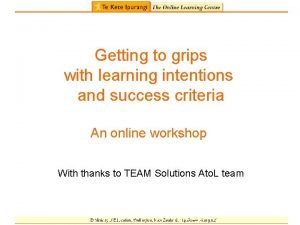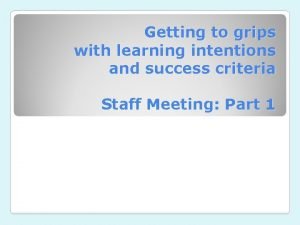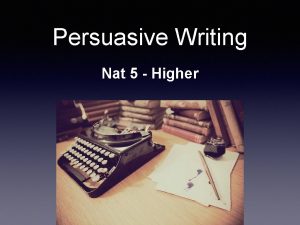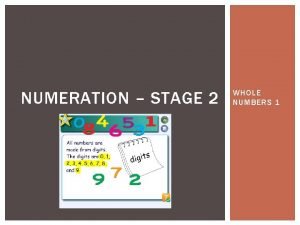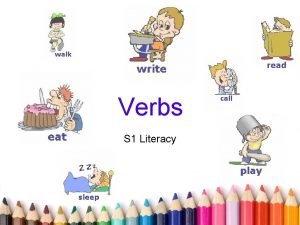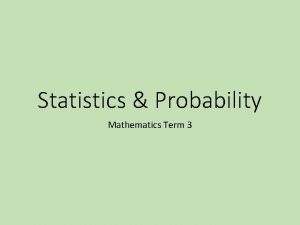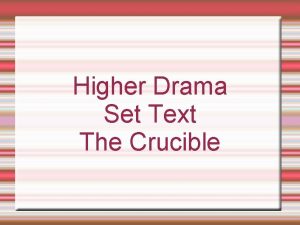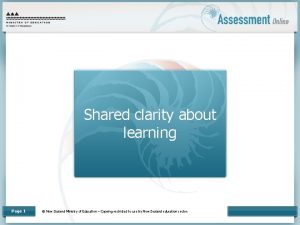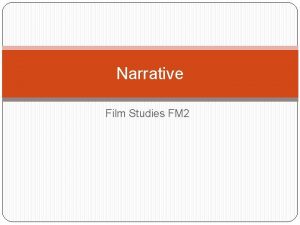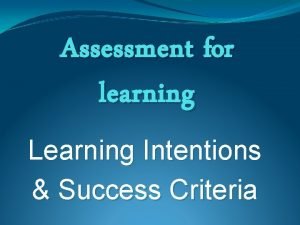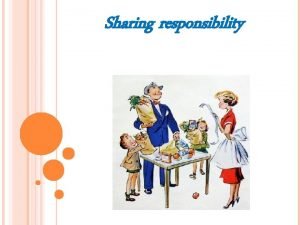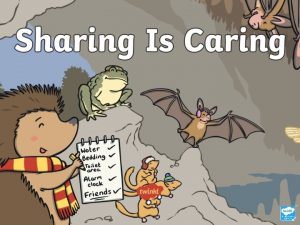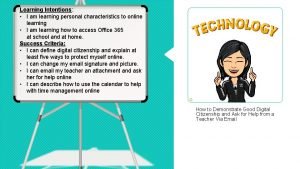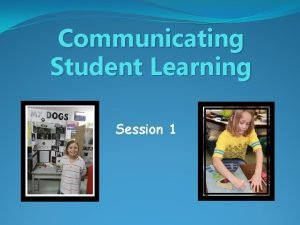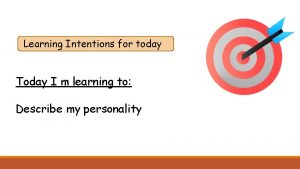Assessment for Learning Af L Sharing Learning Intentions



















- Slides: 19

Assessment for Learning (Af. L) Sharing Learning Intentions & Success Criteria

Learning Intentions and Success Criteria “What classroom practice are managers looking to observe surrounding the use of learning intentions and success criteria? ”

What classroom practice are managers looking for? 1. Teacher knows how to ‘state, share and show’ learning intentions 2. Teacher designs and explains activities that enable the student to learn what we want them to learn – practical use of the 7 design principles of Cf. E 3. Teacher and student work out success criteria together 4. Pupils self/peer assess on an ongoing basis against the success criteria 5. Pupils identify next step(s)

Why Are Learning Intentions and Success Criteria Important? ‘If learners are to take more responsibility for their own learning, then they need to know what they are going to learn, how they will recognise when they have succeeded and why they should learn it in the first place. ’ (An Intro to Af. L, Learning Unlimited, 2004) Learning Intentions ‘What’ and ‘Why’ Success Criteria ‘How to recognise success’

What Is a Learning Intention? ‘A learning intention describes what pupils should know, understand or be able to do by the end of the lesson or series of lessons. ’ (Learning Unlimited, 2004) Learning Intentions: • Identify new learning • Focus on transferable skills

Sharing Learning Intentions 1. 2. 3. 4. 5. Identify what pupils will be learning. Explain the reason for the learning (This is because…). Share (and sometimes negotiate) the learning and the reason with pupils at the beginning of the lesson or activity. Present these in language that pupils can understand. Revisit the learning intention throughout the activity/lesson.

What Is the Learning? Skills Knowledge and Understanding Reasoning (mainly problem solving in its broadest sense) Products Focus on transferable skills when possible These are skills that learners can use in other contexts. This: • helps learners to make connections across the curriculum, • helps them recognise when they are using similar skills in unfamiliar contexts and • makes achievement of learning intention possible for all abilities (it’s the extent to which pupils achieve or demonstrate the intention that will vary).

Defining the Learning Intention Simple Examples: - work effectively in groups - use evidence to draw conclusions - identify odd and even numbers

Defining the Learning Intention cont. • Learning Intention: What are we learning? - To write an effective characterisation. • Context: Vehicle for the learning - Friendship • Activity: What are we doing? - Write a description of your best friend.

Getting the Learning Intentions Right! Activity Give a speech for or against smoking Learning Intention To present a point of view in a persuasive way Draw a bar chart to To present information show pupils in our graphically class come to school Work effectively in a group to design a leaflet to promote healthy eating Context Speech about smoking Bar chart on types of transport used to get to school To be able to work effectively Healthy eating in a group leaflet

Tips: Using Learning Intentions Effectively • Separate the learning intention from the activity instructions • Discuss with pupils why they are learning it • Use child-friendly language (and/or ensure children have the language of learning) - ‘We are learning’ rather than ‘doing’ • Make it visible (display) • Allow time for discussion with pupils

Success Criteria Learning Intentions ‘What’ and ‘Why’ Success Criteria ‘How to recognise success’

Why Are Success Criteria Important? • • • Improve understanding Empower pupils Encourage independent learning Enable accurate feedback Quality assessment is totally dependent on the use of success criteria

What Are Success Criteria? ‘… success criteria summarise the key steps or ingredients the student needs in order to fulfil the learning intention – the main things to do, include or focus on. ’ - Shirley Clarke

Effective Success Criteria… • • are linked to the learning intention; are specific to an activity; are measurable; are discussed and agreed with pupils prior to undertaking the activity; • provide a scaffold and focus for pupils while engaged in the activity; and • are used as the basis for feedback and peer-/self-assessment.

Effective Success Criteria cont. Learning Intention: We are learning to write a narrative. Activity: Write a ghost story. I will be successful if: • people enjoy reading my story; and • it frightens them. • set the scene in the opening paragraph; • build up tension/suspense; • use spooky adjectives and powerful verbs; and • end with a cliffhanger.

Additional Examples We are learning to… present an argument. We are learning to… calculate the passing of time in 5 -minute intervals. Remember to… • include opening and closing • • statements • give reasons for and against • use evidence to support • use language to persuade count from the minute hand stop where the minute hand finishes count in fives go clockwise

Benefits for Pupils ‘Children are more focused and interested, creating a positive learning culture. Their self-esteem is improving also. ’ ‘Success can now be achieved by all, even the weakest children!’ (Findings from Teacher Researchers) ‘We have given children the vocabulary to discuss their own work. ’ ‘Pupils are beginning to talk more about how they are learning rather than what they are learning. ’

Benefits for Teachers ‘I’m more sensitive to individuals’ needs/achievements. ’ ‘Relationships between teacher and pupils are warmer and more positive. ’ (Findings from Teacher Researchers) ‘Sharing learning intentions and success criteria at the beginning of the lessons has resulted in teacher and pupils working more in partnership towards a common goal. ’ ‘My planning is more effective/focused/ thoughtful. ’
 Jabberwocky alliteration
Jabberwocky alliteration Learning intention examples
Learning intention examples Learning intentions examples
Learning intentions examples Learning intentions and success criteria examples
Learning intentions and success criteria examples Nat 5 persuasive essay
Nat 5 persuasive essay Place value learning intentions
Place value learning intentions Poetry learning intentions
Poetry learning intentions Fraction learning objectives
Fraction learning objectives Half turn symmetry shapes
Half turn symmetry shapes Learning intentions verbs
Learning intentions verbs Poetry learning intentions
Poetry learning intentions Learning intentions and success criteria for mathematics
Learning intentions and success criteria for mathematics Poetry learning intentions
Poetry learning intentions Orchids poem questions and answers
Orchids poem questions and answers Creative writing learning intentions
Creative writing learning intentions Features of acrostic poems
Features of acrostic poems The crucible character map
The crucible character map The meaning of advent worksheet
The meaning of advent worksheet Shared clarity about learning intentions
Shared clarity about learning intentions Narrative learning intentions
Narrative learning intentions

